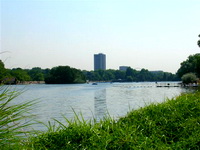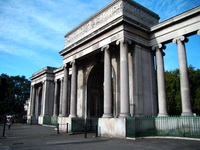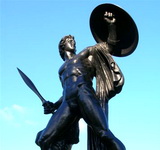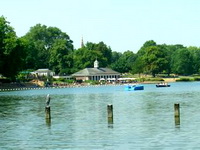Dave the Taxi Driver's
|
| |
|
Dave the Taxi Driver's | |
|
|
|
 |
 |
 |
 |
Hyde Park/Kensington Gardens
Anyone who looks at a map of Central London will notice the familiar rectangular shape of Hyde Park/Kensington Gardens. The ‘Park’ as it has been known for centuries, even though it is by far not the only major park in London, (but is the largest open space), became a Royal Park after Henry VIII seized the lands from the Church in 1536. |
|
Henry’s dispute with the Catholic Church came about because the Pope refused to grant an annulment of Henry’s marriage to Catherine of Aragon. Behind the scenes he had committed an infidelity with Anne Boleyn, in fact probably many more than one. He wanted Catherine out of the way so that he could marry Anne, but the Pope refused to grant the annulment. Henry’s response was to ignore the Pope and divorce Catherine. In 1533 Henry broke away from the Catholic Church, installed himself as Head of the Church of England and married Anne Boleyn. Thereafter during the Dissolution of the Monasteries church property and land were confiscated by the Crown. This was not an isolated action as the Reformation was already underway in Europe but Henry’s actions were not borne from religion but from ego and politics. |
|
It was the significant acquisition of the Manor of Eia from which Hyde Park was to come into being and which assured its destiny as the great open space it is today. Henry being an avid huntsman decided to sell Eabury and Neyte and keep Hyde to add to his hunting grounds which, by this acquisition extended further westward and northward all the way from The Palace of Westminster up to Hampstead and Highgate. There were more animals there in those days than people; bulls, wild boar, deer and game. The Manor of Eia consisted of three estates, Eabury, Neyte and Hyde. During Saxon times it belonged to the Master of the Horse but after the Norman Conquest by William I in 1066 all land in England was taken by the Normans and divided amongst the noblemen. The Manor of Eia had been bequeathed to the Church by the owner Geoffrey de Mandeville in the late eleventh century. |
|
There used to be a Roman military road, the Via Trinabantinum which led from the City to Silchester. This roughly follows the route of Oxford Street and Bayswater Road. Another Roman road, Watling Street corresponds to Edgware Road and eventually leads to the Kent coast. With the road to Reading to the south, these roughly defined the Park’s boundaries. |
|
It became the height of fashion to parade there dressed in your fine clothes. Men known as ‘Dandies’ would stroll (or perhaps mince) around in what I think would have been considered flamboyant or maybe peculiar garb. These men had long hair at the sides with ribbons tied on. These were known as lovelocks. They used to decorate their faces with designs such as stars and moon and wear spurs which would jingle as they walked. This, I believe was to attract the ladies. Festivals were held on May Day and thousands would go there on Sundays, to eat drink and be merry. The well off would partake of syllabub ,a dairy dish, accompanied with sack, the rough dry sherry. We hadn’t invaded India yet so there was no tea. The Park was the place to be seen. From then on it was the place for the rich to display the latest fashions. But troubled years lay ahead. James I believed himself to be King by divine right. This attitude prevailed throughout the reign of his son Charles I. There was great conflict between the King and parliament . The English Civil War began in 1642. Charles I had fortifications built in the Park where his troops which were known as ‘trained bands’ would exercise. During the 1630s the Park was opened to the public for the first time and took on the identity that became its future. The Park became the Resort of London and it has remained so down to modern times. |
|
Under Puritan rule strict social reforms took place. Horse racing gambling, cock-fighting and theatre were all banned. Drinking alcohol was discouraged and attendance at church was compulsory. Cromwell as Lord Protector ran a military government and ignored Parliament when it suited him just as Charles I had done. The Commonwealth, as it was known was in effect a dictatorship. In 1652 being a Royal Estate, Hyde Park was sold off for £17068. 2shillings and 8 pence. From then on it cost one shilling for a coach to enter the Park and 6 pence for each horse. After Cromwell’s death in 1659 it was clear that the people were unhappy with the austere form of government during the puritan years.Coach Races were very popular in the Park .Oliver Cromwell had a serious accident in Hyde Park when he lost control of the horses pulling his coach. He was dragged along between the horses and despite his pistol firing off in his pocket, he survived the ordeal, to the dismay of Royalist supporters. |
|
Hyde Park was taken back by Charles. It was reopened to the public and once again it became the fashionable place it used to be, the theatre of the people. Just north of where the Serpentine is now there used to be a circular area which was bordered by railings. That was called the Tour or more famously The Ring. The Ring was the haunt of the beautiful people who would ride around in their fine carriages passing each other on numerous occasions waving, exchanging wit and pleasantries and no doubt flirting. Bearing in mind the reputation of the Ring, on one occasion King Charles having attended a ceremony on St. George’s Day with The Knights of the Garter decided that it would be fitting to go to the Ring and parade in their ceremonial clothes. So they kept their robes on until later in the day and did just that, King Charles still wearing his crown. That’s a King with a sense of humour. Certainly upstaged the dandies.Charles though, over the years also had many difficulties with Parliament but the political strife which caused the English Civil War never reoccurred. He was a popular king, the father of many illegitimate children and was known as the ‘Merry Monarch’. Charles had the park enclosed by having a six foot wall built. The view from Park Lane was not very good for the next 150 years. George II increased the height of the wall to eight feet. It was George IV that did away with the wall and put iron railings in its place. |
|
|
|
When William III came to the throne in 1689 he decided that because of his asthma he would rather live away from the River Thames with its damp atmosphere so he bought Nottingham House. This stately home was built in what was Hyde Park but became Kensington Gardens in 1728 when Hyde Park was reduced to half its size at the will of Queen Caroline, the wife of George II. |
|
The Westbourne, admittedly was not of Amazonian proportions but it was at least a respectable river. At the south eastern end of the Serpentine you will find a weir. Beyond this is a quiet little backwater. Here is what remains of the flow of the Westbourne as it exits the Park and makes its way underground through a very expensive area, eventually flowing through a conduit under Sloane Square to the Thames, giving up its energy and history to the London sewer system. While you’re pondering this give a little bread to the waterfowl that I am sure will be running towards you. |
|
Meanwhile it is recorded that the effeminate would still parade in their finery. This was regarded by some as an insult to the fine men of old that fought and protected England. |
|
|
|
So gradually Hyde Park started to become what it is today. The Industrial Revolution and the coming of the Railways caused the completion of the urbanisation of the surrounding areas. The term urbanisation is perhaps not truly representative. These were the elegant estates in Mayfair, Belgravia, Knightsbridge and Kensington which stand today as examples of classical and beautiful architecture. In 1805 the Powder Magazine was built just north of The Serpentine. In 1814 there was a mock staging of The Battle of Trafalgar which took place on the Serpentine and involved blowing up the French Ships to much cheering and rejoicing. Next to Apsley House at The Grand Entrance stands the Ionic Screen designed by Decimus Burton. This was built in the 1820s The Coronation of George IV was celebrated by fireworks in 1820.
The Serpentine Bridge which affords such lovely views of the Serpentine and the Long Water, was built in 1826. The nineteenth century saw great events within the Park. There were many celebrations and many drinking tents and cake houses to entertain the masses who had come to London on the crest of the industrial upsurge. |
|
The Park throughout the nineteenth century took on a more formal appearance. Gates such as the Prince of Wales Gate, Albert Gate and Edinburgh Gate were built. It is said that the Great Exhibition was the reason that The Knowledge of London came into being. At the time the cab drivers were only used to doing local trips. The millions of visitors that the Great Exhibition attracted obviously wanted to go further afield so the training and examination of the Knowledge was born. |
|
Later in the 1800s there were a number of demonstrations in the middle of the Park. These were illegal and were severely dealt with by the Army and later the Police. They centred around what is known as The Reformers’ Tree. The largest was a gathering of 150.000 demonstrating against the proposed Sunday Trading Laws.
|
|
|
|
The Party in the Park is held every year in July. I went there with my wife and daughter in 2001. Surprisingly my wife and I were not the oldest teenagers there. There was the Live 8 Make Poverty History Concert in 2005 and there are regular modern bands playing there in summer. The last night of the Proms synchronised with the concert in the Albert Hall in September and beamed to and shared with the rest of Britain is a real stalwart of culture. There is also a funfair at Christmas along North Carriage Drive. Occasionally you will also see marquees erected near Marble Arch for other events such as the Startrek one some years ago. |
|
The Serpentine Gallery which specialises in exhibitions of modern and contemporary art is open daily from 10.00a.m. to 6.00p.m. There are also the Tea Rooms next door.
|
|
|
|
The Tennis and Sports Centre is close to The Alexandra Gate and has a café. There are other refreshment establishments such as at Speaker’s Corner, Serpentine Bridge, the Dell Restaurant at the other end of the Serpentine , The Lido Café and The Broadwalk Café plus a few smaller coffee houses. |
|
There are also children’s playgrounds near Victoria Gate and opposite Hyde Park Barracks. You could spend a week here but I recommend you go back to your hotel at night. Although cars are permitted in Hyde Park as well as taxis (quite rightly so), commercial vehicles are not allowed unless on necessary business, so a permit will be required. Traffic access is via Alexandra Gate, Cumberland Gate, Edinburgh Gate, Prince of Wales Gate, Queen Mother’s Gate and Victoria Gate. It is over three miles around the perimeter and there are numerous other gates for access. The Royal Parks Department can be contacted for detailed information. Guided walks are organised by The Royal Parks and Prince Michael has been instrumental in making facilities for the disabled available. |
|
There are those who claim that to be a London Taxi Driver is the best job in the world. There are probably about three billion others who disagree. While millions of people are swarming through the underground and packing themselves onto buses I am able to take time out and walk in Hyde Park.
Hotels
South of the park on Kensington Road the 3-star Best Western John Howard Hotel offers an oasis of tranquillity and elegance in the heart of London along with free satellite TV and wireless internet access. The 5-star Royal Garden Hotel has spectacular London views, 3 bars and 2 restaurants, including Min Jiang on the 10 floor with its spectacular views over Kensington Gardens and a holistic spa. The luxurious 5-star Sheraton Park Tower Hotel offers award-winning dining and stunning views of London from every room. You can find many more hotels with photos, descriptions, maps and booking information on the Hotels Page
Nearest underground
Any questions? E-mail me For tours, transfers and other taxi services see Dave's Taxi Page |
|
|